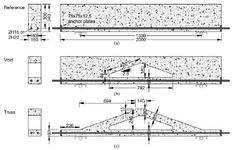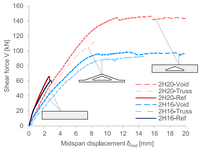I came across this paper recently which has me quite puzzled.
In summary, 3 types of deep-ish beams (L/D = 4.4) were tested to failure. The first, a simply-supported rectangular beam ("Reference"); the second with an inner void formed to match the assumed strut-and-tie arrangement ("Void"); and the third with additional concrete removed above the struts ("Truss") - refer to the below sketches. Two specimens of each type were tested.

Surprisingly, even though each beam can be thought of as having the same internal strut-and-tie arrangement, the Reference beam is found to be significantly weaker than the other two (by about half). It also exhibits very limited ductility, ultimately failing in conventional shear; whereas the Void and Truss beams were quite ductile and seemed to reach the yield point of the reinforcement. Results are shown in the graph below:

If only one specimen of each type had been tested, you could be forgiven for writing this off as a fluke. But the results are consistent.
According to the authors, the Reference beams exhibited a lack of internal redistribution, preventing the development of the assumed STM. It seems as though the Reference beams developed initial flexural cracks which propagated diagonally and ultimately failed in conventional shear; whereas the voids in the other beams prevented these flexural cracks from propagating, avoiding this type of failure.
How, then, are these results supposed to be interpreted? I have not run any numbers to see what the theoretical strut-and-tie capacity would be. It may be the case that the Reference beams actually performed adequately based on the quantity of reinforcement and concrete dimensions (and that the Void and Truss beams simply had some unexpected additional capacity). The strut angle of ~20° is flatter than most codes would allow, but that does not seem to have been an issue for the Void and Truss beams.
As a side question, are there any other situations in structural engineering where less is more?
In summary, 3 types of deep-ish beams (L/D = 4.4) were tested to failure. The first, a simply-supported rectangular beam ("Reference"); the second with an inner void formed to match the assumed strut-and-tie arrangement ("Void"); and the third with additional concrete removed above the struts ("Truss") - refer to the below sketches. Two specimens of each type were tested.

Surprisingly, even though each beam can be thought of as having the same internal strut-and-tie arrangement, the Reference beam is found to be significantly weaker than the other two (by about half). It also exhibits very limited ductility, ultimately failing in conventional shear; whereas the Void and Truss beams were quite ductile and seemed to reach the yield point of the reinforcement. Results are shown in the graph below:

If only one specimen of each type had been tested, you could be forgiven for writing this off as a fluke. But the results are consistent.
According to the authors, the Reference beams exhibited a lack of internal redistribution, preventing the development of the assumed STM. It seems as though the Reference beams developed initial flexural cracks which propagated diagonally and ultimately failed in conventional shear; whereas the voids in the other beams prevented these flexural cracks from propagating, avoiding this type of failure.
How, then, are these results supposed to be interpreted? I have not run any numbers to see what the theoretical strut-and-tie capacity would be. It may be the case that the Reference beams actually performed adequately based on the quantity of reinforcement and concrete dimensions (and that the Void and Truss beams simply had some unexpected additional capacity). The strut angle of ~20° is flatter than most codes would allow, but that does not seem to have been an issue for the Void and Truss beams.
As a side question, are there any other situations in structural engineering where less is more?
